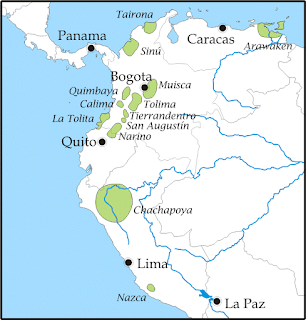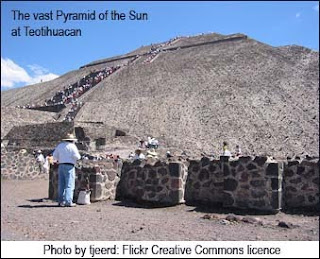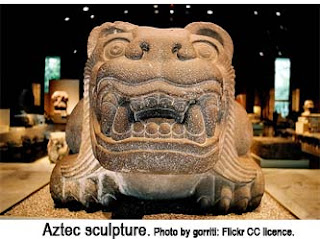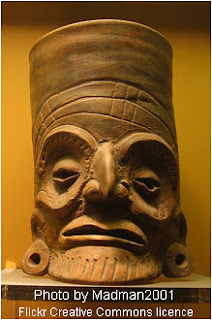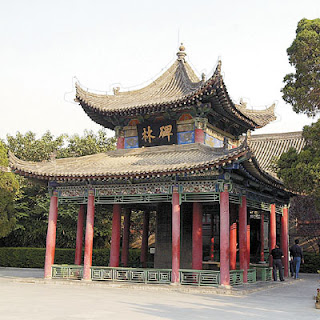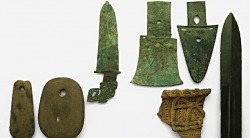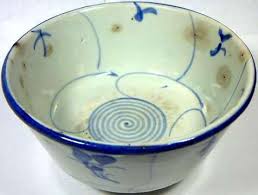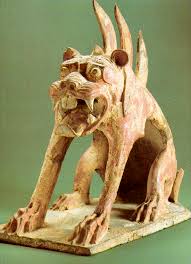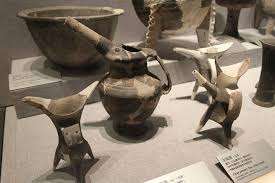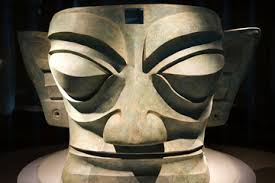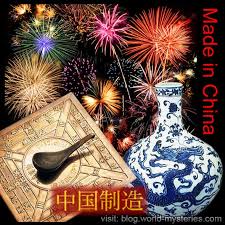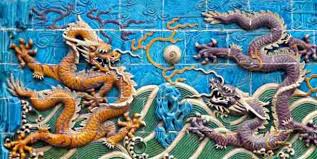The pre Columbian Civilisations of Central America - The Mesoamericans
This prints onto 8 A4 pages.
The Olmec, Teotihuacan, Toltec, Maya and Aztec
There is a pre Conquest history of civilisations in Central America that extends back 3,500 years. It’s thought that humans have been in the Americas since 12,000 – 18,000 years BC. The earliest human artefacts found so far are from Chile and date to around 11,000 BC. By the 15th century AD most of the Americas were quite heavily populated. In total the population of the Americas in pre Colombian times is estimated to have stood at around 40 million people - it may have been higher
Central America is a volcanically active region and subject to earthquakes, tropical storms and El Nino/La Ninaevents. It holds a wide variety of often challenging environments and climatic regions. The environment and climate played a significant role in shaping their mythologies and cultures. Below is a brief introduction to the peoples and cities, to help you get your bearings in time and place.
The ancient peoples of the north American Southwest, Mexico and Central America are collectively known as Mesoamericans; and identified by various shared cultural, artistic and religious characteristics.
They were primarily agriculturists, with maize, beans, squash, peppers and fruits forming the staple diet along with meat from wild game and fish when available. The only domesticated animals were turkeys and small dogs. They had no iron (only one small Maya state, Tarascan, was using bronze at the time of the Spanish conquest), did not have the wheel or oxen, horses or mules and their tools were made from hard stones such as flint. Their weapons used obsidian blades, this can be sharper than honed steel.
Map above to show geographic spread of Maya cities(there are a great many more not depicted)
plus location of Teotihuacan & El Tajin.
The earliest evidence for agriculture in Mexico appeared at around 8,000 BC. Maize was being consumed 6,500 years ago (Maize derives from a large wild grass called Teosinte.), domesticated maize cultivation has been dated at around 3,500 BC; beans and squash were being cultivated and large reservoirs constructed in the first millennium BC.
Many Mesoamerican cultures had religious imagery in common. A brightly plumed bird symbolises the heavens, a jaguar the physical world whilst a snake represents the underworld. A tree connects the physical world with both the underworld and heavens. Quetzalcoatl was a Toltec/Aztec creator deity; part bird [Quetzal], part snake [Coatl]. (Quetzals are birds with brilliantly coloured feathers found in Central America, noted for their long tail feathers. Example left. The feathers were used to make elaborate cloaks and headdresses.) Many Mesoamerican cultures also had in common a ball game played with a heavy rubber ball; goals were scored by passing the ball through a hoop mounted on a steep, sloping wall of a masonry ball-court. The outcomes of these games could be a matter of life and death; there is evidence for a losing squad being ritually executed, but this was not the norm. The game may have had religious significance attached to it. You can find out more about this ball game here.We have some written record of these cultures histories and intellectual achievements; by no means as much as we do for, say, the ancient Greeks, but they must have been quite substantial to have achieved as much as they did; particularly in the face of climatic adversity. Their mathematics was quite advanced; the Maya used zero, this the Greeks and Romans never discovered. Their architects and artisans have also left a significant legacy that speaks for itself. The many ancient pyramids and cities in Central America are the remains of civilisations that are comparable with those of the ancient Egyptians, Sumerian's and Persians etc.
The Olmec, Teotihuacan, Maya, Toltec and Aztec peoples were all great builders of cities; and astonishing sculptors in stone, wood and bone. Rivers were used to transport goods in canoes. Reeds were used in basketwork and to thatch roofs. Brightly coloured shells, bird feathers and animal skins (particularly Jaguar) were all highly prized status symbols. Stones and gemstones such as jade, obsidian and basalt, along with gold, copper, rubber, amber, cotton, fish, tobacco, chocolate, spices, salt and dyes were all important trade items. Turquoise was imported from the American southwest. Their mythology and histories were recorded in hieroglyphs. They had two calendars. Central America largely used a complex Calendar Round, based on 260 days in a year, following 52 year cycles.
The Maya inherited from the Olmecs a highly accurate calendar, known as the Long Count. (The Long Count began on13th August, 3114 BC – why this date was chosen is unknown.) Usefully, the Maya habitually dated buildings, monuments and recorded the dates of significant events in their hieroglyphs. Once the Long Count was understood (and correlated against our own calendar) buildings, events, rulers and distinct periods could all be dated with a high degree of accuracy.
The Olmec civilisation began in around 1250 BC and was the first to build cities. The Olmec developed out of a number of chiefdoms, each comprising many thousands of people, with a sophisticated artistic style in pottery and statuettes; they are best known for their gigantic head sculptures. (Left.)
So little is known about them that historians are unsure how best to define the Olmecs. They could be defined as cultures that had both a religious tradition and artistic style in common. The Olmec were a significant influence on the development of subsequent Mesoamerican civilisations over a very wide area. One of their legacies was the introduction of the Long Count calendar.
The Maya inhabited Mexico’s Yucatan peninsula and parts of the countries we now call Guatemala, Belize, Honduras and El Salvador. (On a map – the Yucatan is on the SW side of the large bay that forms the Gulf of Mexico. Cuba is the nearest Island. Facing the peninsula, across the Gulf, is Florida.)
Maya is a collective name for a peoples whose languages form a family (Much as northern European languages are described as being of Germanic origin.) and display shared cultural traits. The Mayadeveloped from the Olmec civilisation.
The Maya were divided by geography into a number of powerful regions, each containing many city-states, each ruled by ambitious dynastic families. There were numerous internecine wars, both between regions and within regions. The Maya, their cities and the reason for their abandonments (drought) is covered in greater depth elsewhere on this site.
Click here for a more detailed map of the Maya lands
Use Back button to return here..
It is estimated that one, the Tikal city-state, had 60,000 people living in the city and up to half a million inhabitants in its surrounding lands.
The Maya population has been estimated at between 5 – 10 million people. The farmers that supported these city-state populations were industrious; employing jungle-farming and raised field methods and also clearing large tracts of jungle. Following the demise of theMaya the jungle reclaimed the land and engulfed the cities. The cities tourists visit today have been cleared of the jungle growth.
Following the collapses of the cities the Maya didn’t completely ‘disappear’, their descendants populate the region today - and other peoples migrated into the region. But following the abandonments they could not regroup, rebuild and regain their former high-point.
At the time of the Spanish conquest, after the abandonment periods, the surviving Maya still existed as 16 city states. One of these – Itza on the island of Tayasal – put up stubborn resistance until finally defeated in 1697. The Spanish had a hard time gaining possession of Maya lands. Politically the Maya were organised into autonomous city states, that had been fighting each other for centuries; they adopted guerilla tactics against the Spanish. This meant there was no single central authority for the Spanish to capture, as with the Aztecs or Inca, or a single army to engage with in battle. Even after the fall of Itza there were numerous uprisings.
Teotihuacan was founded in the first century AD and in its time was one of the largest cities in the world, larger than most in Europe. This was Mexico’s equivalent of Luxor or Babylon.
There are signs of Mayan influence around Teotihuacan; a Teotihuacan lord is thought to have founded a dynasty that ruled the Maya city of Tikal for a period (this caused a war with its neighbours) but much remains to be learnt of this intriguing long distance relationship.Teotihuacan was a planned city, laid out on a grid covering 8 square miles. At it’s height the city’s population was between one and two hundred thousand, but its power and influence extended across Mexico and into the Yucatan. Above: Teotihuacan's mile long Avenue of the Dead seen from the Pyramid of the Sun. The Pyramid of the Moon is in the far distance. Teotihuacan is best known today for its two massive Pyramids - of the Sun and Moon - that are connected by the Avenue of the Dead. Teotihuacan reached the heights of its power in the fourth century, but went into decline around 530-590 AD. This coincides with the period of Mayan abandonments known as the Hiatus; whilst in Peru, between 563 to 594 AD, there was a coastal drought so severe the Moche were forced to relocate their capital city. It is thought drought conditions placed Teotihuacan’s agriculture under too great a strain to support such a large economy.
NB: A tree-ring and lake bed sediment core study found that in the eighth century AD a great drought extended from the northern Great Plains of N. America, across the southwestern United States and into central Mexico and the Yucatan peninsula. In Colorado and New Mexico severe drought is shown there for A.D. 735-765. (Stahl et al. 2002.) Teotihuacan would have been affected by this drought; by its direct impacts on its agriculture and reservoirs and certainly by the waves of migrants fleeing their homelands in the north.
The final act was in 750 AD when the central buildings of Teotihuacan's state and priesthood were burnt and vandalised; possibly in an internal revolt. (There is a pattern in the fall of cities in Mexico and also in Peru, of major religious and state buildings being vandalised at the final act in their collapse. As rulers and religious leaders claimed to be able to intercede with the gods to ensure plentiful rains and good harvests, a natural calamity could result in rebellion by a population that turned against their elite.)A neighbouring city, Cholula, also was abandoned at around the same time as Teotihuacan. In the eighth century the Toltecs had also begun to establish themselves in the region; they would be the next significant power to rise. Not much is known about the people who built Teotihuacan. The Totonac peoples that built El Tajin claim to have played a major role, but no-one really knows. Teotihuacan’s massive legacy exerted a major influence on the Toltecs and also on the later Aztecs. Awestruck Aztec rulers made pilgrimages to view Teotihuacan's pyramids and buildings.
The collapse of Teotihuacan, during a period of drought, left a power vacuum that several city states attempted to fill over the course of the next few hundred years. The Maya seem to have had significant influence on two: Xochicalco and Cacaxtla. Others were Cantona,El Zapotal and Alta Vista.
El Tajin was the most significant of several cities on the Gulf coast during this time.TheClassic Veracruz period; this ended with a great flood that devestated El Tajin in 1100 AD).
The next civilisation to hold sway over much of central Mexico came from a great wave of migrants from north Mexico and beyond at around the time Teotihuacan lost its remaining authority in 750 AD. (See above.) These migrants appeared during a time of great droughts, presumably fleeing their homelands. The Toltec are thought to have originated from the Sierra Madre mountain in the west of Mexico; also forced to migrate due to a period of drought. They came from the same language family, uto-Aztecan, and culture, Chalchihuites, as the later Aztecs. The Toltecs and Aztecs shared a common language called Nahuatl, and both states sacrificed victims to their rain god, Tlaloc.
The Toltecs became dominant in Central Mexico between the 9th – 12th centuries. Their capital city was Tula (aka Tollan), at its height this had a population of around 40,000. There appears to be a connection between Tula and the Maya city state of Chichen Itza, 650 miles away in the Yucatan peninsula. The two cities appear to have shared similar political and religious traits and had a common artistic style; it is not yet known if this occurred primarily through conquest, political alliance or trade. There is uncertainty as to whether Tula influenced Chichen Itza, or if the reverse was true. The Toltec's influence sprang also from their extensive trade links and artistic styles (e.g. Water container on left).
The Toltec civilisation began to collapse from the 1150’s onwards, again during a period of severe drought and conflict, Tula’s fall is dated at 1179 AD, when it was invaded by nomadic Chichimecs(from whom the Toltec were also descended), escaping drought to the north, and the Toltec king was put to death. Apparently the invaders then found there wasn’t enough food to feed their forces, many warriors died. The surviving Toltecs dispersed across Mexico. The Toltec were a major influence on the later Aztecs, who openly admired their cities, and copied from both Toltec and
The Aztecs (aka Mexica) occupied most of what we now call Central Mexico and were a caste based, warrior culture. They migrated from their stronghold (Aztlan) in north-western Mexico. The reasons for this migration was probably drought intheir homeland(see Toltecs above); it is clear that the decision to move was forced on them; many Chichimec tribes migrated along with them - the Aztecs were the last to arrive in central Mexico. The Aztecs arrived at the Valley of Mexico in around 1200 AD.
The only vacant lands the Aztecs could find to settle on were inhospitable swamps near Lake Texacoco; they quickly established themselves as both hardened mercenaries and exceptionally able agriculturists.
Even by the standards of their day (all Mesoamerican cultures practised human sacrifice), the surrounding civilisations viewed the Aztec religion and traditions with horror
One quite famous story (apparently true, according to Aztec chronicles), set before the Aztecs reached the Valley of Mexico, has an Aztec leader requesting the daughter of Achitometl (ruler of a tribe called the Culhuas) as a bride for Huitzilopochtli*. Believing that this indicated the start of a dynastic alliance by marriage Achitometl agreed, but a few hours later found an Aztec priest walking round wearing his daughter's flayed skin. Achitometl reacted violently, the Aztecs fled. (* Huitzilopochtli was an Aztec war god; Aztecs believed that tokeep the world in motion, they had to feed this god human blood every day. 'Brides' were sacrificed!)
The Aztecs' rise was swift; with a combination of strategic alliances, trade, dynastic marriages and shrewd leadership they pursued an aggressive policy of conquest, becoming the successors to the Toltecs. The Aztec capital city was established at Tencochtitlan (modern day Mexico City) in 1325 AD at Lake Texacoco (Lake Mexico). Tencochtitlan was based around and on this lake's islands. Aztec farmers were innovative, creating artificial islands and draining wetlands to make best use of available water and land. Tlatelolco was a nearby Aztec city. The Spanish Conquistadors later compared Tencochtitlan with Renaissance Venice.
The Aztec economy was largely based on forcing neighbouring states into paying vast amounts of tribute. Warfare was largely directed to this end, but also to procure sacrificial victims. Aztec mythology, culture and religion was based around blood sacrifice in order to ensure rainfall and fertility. They had one symbol representing both water and blood. The huge numbers of human sacrifices also served to terrorise neighbouring states into paying tribute. (NB: Knives, be they of obsidian or steel, are not good implements for cutting through rib-cages. The Aztec method of heart sacrifice was to cut just below the rib cage, then to push a hand up to the beating heart, in order to grasp and rip it out. They killed hundreds of thousands this way.) See also note at bottom of page. Despite being a ferocious warrior culture with such a bloodthirsty religion, the Aztec’s great wealth meant their artisans could develop a highly sophisticated artistic style in sculpture, ceramics and architecture; they were heavily influenced by both Toltec and Teotihuacanstyles.
The Aztecs didn’t have it all their own way. There were other states in Mexico at this time; some too powerful for the Aztecs to conquer or intimidate. Other states were allowed to remain independent, so the Aztecs could raid them for sacrificial victims and demand that tribute be paid.
The army of Spanish adventurer Hernan Cortes brought an end to the Aztec empire in 1521 AD. Cortes first captured the Aztec's indecisive emperor Moctezuma (who later died in a struggle); then recruited an army of warriors from neighbouring states (in particular Tlaxcala and Huexotzingo), who wanted to rid themselves of the burden of tribute paid to the Aztecs.Some estimate that at the time the Spanish first arrived, the population of the Central Mexican Plateau was as high as 25 million people; the combined populations of Spain and Portugal at that time was 10 million people. The Aztecs had made many enemies; their capital city was taken and it’s inhabitants slaughtered. Diseases brought by the Spaniards to the Americas, particularly smallpox, also severely weakened Aztec resistance. Some estimates say this disease killed over 3 million Aztecs; the Mesoamericans had no immunity to diseases brought by the Europeans. (See also Notes at bottom ofthis page.) The Spanish conquest in the America had begun in earnest and would continue for a long period afterwards. |
Introduction :
Most Mesoamerican and pre Columbian civilisations and cultures, to a greater or much lesser extent, practised ritual human sacrifice. In these societies religions and cults were centred on preventing disasters and ensuring fertility (though there were also a number of warrior deities and cults). In common with many early agriculturally based civilisations (across the world) this represented a desire to control the weather and climate. Victories in battles or palace coups were often celebrated by the public ritual sacrifice of the vanquished elite. People also appear to have been sacrificed as part of rituals connected with the building of temples and also on the death of a high status ruler.
For some societies human sacrifice was a means of last resort; an attempt to appease apparently wrathful gods. The Aztecs however took a more proactive view - that by offering enough sacrifices catastrophes could be held at bay.
The Aztecs demonstrated a stubborn belief that this might work, in the face of experiences that pointed to the contrary. Theirs seems to have been a religion based on fear. As well as capturing sacrificial victims from other states, Aztec people appear to have volunteered for sacrifice or practised quite gruesome acts of ritual self-mutilation (as had the Maya also). At around the time the Spanish conquest began it is thought that the Aztecs were annually sacrificing tens of thousands of people to their rain god, Tlaloc. The Aztec capital fell to Cortes in 1521 AD.
At the maximum of the glacier advances in the Alps (1560-1620 AD), a Witch hysteria gripped many Alpine villages. The Lutheran Church believed worsening conditions were a sign of God’s wrath. Villagers lost no time in accusing their neighbours of behaviour likely to have brought this wrath down upon them. Thousands of people, mainly women, were burnt at the stake (1,000 in the Bern region alone) before the hysteria ran its course. (The Little Ice Age. B. Fagin. Basic Books. 2000.)
Many Iron and Bronze Age cultures’ religions appear to have viewed death as a journey to a physical afterlife. Many societies sacrificed humans (often slaves and servants) and animals (horses, dogs etc.) to accompany their rulers on this journey. e.g. the rituals that accompanied Viking and ancient Egyptian funerals - and revealed also by excavations of Iron and Bronze age burial sites in Europe, China, Central Asia, India and the Americas.
Many Iron and Bronze Age agrarian societies worshipped their rulers as semi divine - in the belief they had power to control the elements - and turned against them if they were thought to have failed. Shrewder rulers quickly realised the benefits of stockpiling food reserves in case of crop failure, planning irrigation projects, building reservoirs and the like. But a combination of droughts or floods, lasting two or more years, could cause populations to rebel and societies to collapse into civil warfare. Such societies were also vulnerable to invasion by neighbouring peoples fleeing natural disaster in their homelands.
Note: 'Pre Columbian': In 1492 Columbus reached the Bahamas. This is generally taken to be the date from when the Europeans began to realise that a major continent lay across the Atlantic. The European discovery of America was an accident, Columbus had hoped to reach the East Indies - SE Asia - by sailing around the world.
At that time passage from the Atlantic, around the southern tip of Africa and into the Indian ocean hadn't been achieved. Columbus knew the world was round, but underestimated the world's circumference; he also didn't realise that a continent was in his way! Usefully his pilot may have had some knowledge of the winds and currents that carried Columbus westwards, and that by then sailing northwards and using the Gulf Stream they would find winds and currents that would carry them back eastwards towards home. The real significance of this voyage was that it was a return trip.
Before Columbus, from 1001 AD, some Greenland Norse - led by Leif Eiriksson - had made some explorations of Baffin Island, southern Labrador, Newfoundland and the Gulf of St. Lawrence; establishing a short-lived summer settlement at L’Anse aux Meadows in Newfoundland. (Excavations have recovered over 2,000 Norse objects from this site.) These Norse traded metal tools and woollen cloth with Beohuk Amerindians in return for animal pelts and walrus tusks [ivory fetched a high price in Scandinavia]; but trade disputes led to some violence (Leif Eiriksson's brother, Thorvald, was killed in one of the disputes with the Amerindians.) and eventual abandonment of the settlement in around 1010 AD. Eiriksson offered to rent out the small houses in L'Anse aux Meadows to any Norse looking for adventure and trade opportunities; but any interest faded away over the next decade. There is evidence that other Norse made some exploratory voyages to other parts of the north-eastern American coasts, in search of pelts and timber.
Although the Greenland Norse reached (and so were the first modern Europeans to discover) the north-eastern coast of America, they appear to have only seen this in terms of short-term gain for themselves; not as a major opportunity for the Norwegian Norse in general.
Leif Eiriksson named one part of the area they explored Vineland; this probably referred to L'Anse aux Meadows - but there is disagreement amongst historians over where exactly he meant? It unlikely this question will ever be satisfactorily resolved.
The Norse don't appear to have seen any great potential in Newfoundland, other than for some limited trading opportunities. The Spanish that came after Columbus took a very different attitude towards the Americas; they saw opportunities for plunder, land and wealth and aggressively pursued them. Spanish histories report Cortes saying to the captured Aztec emperor Moctezuma: "We Spanish suffer from a strange disease of the heart for which the only known remedy is gold."
It is also thought that Basque fishermen (and possibly others) might have known of the productive fishing grounds off the eastern North American coast before Columbus made his voyage; but kept this information a closely guarded secret. In 1534 the Frenchman, Jacques Cartier, explored the Gulf of St. Lawrence and claimed it for France. Accounts of Cartier making an official proclamation claiming his 'discovery' noted that he did so in full view of a fleet of 1,000 Basque fishing vessels, that had arrived independently. The Basques clearly had known of the area before Cartier.
At that time passage from the Atlantic, around the southern tip of Africa and into the Indian ocean hadn't been achieved. Columbus knew the world was round, but underestimated the world's circumference; he also didn't realise that a continent was in his way! Usefully his pilot may have had some knowledge of the winds and currents that carried Columbus westwards, and that by then sailing northwards and using the Gulf Stream they would find winds and currents that would carry them back eastwards towards home. The real significance of this voyage was that it was a return trip.
Before Columbus, from 1001 AD, some Greenland Norse - led by Leif Eiriksson - had made some explorations of Baffin Island, southern Labrador, Newfoundland and the Gulf of St. Lawrence; establishing a short-lived summer settlement at L’Anse aux Meadows in Newfoundland. (Excavations have recovered over 2,000 Norse objects from this site.) These Norse traded metal tools and woollen cloth with Beohuk Amerindians in return for animal pelts and walrus tusks [ivory fetched a high price in Scandinavia]; but trade disputes led to some violence (Leif Eiriksson's brother, Thorvald, was killed in one of the disputes with the Amerindians.) and eventual abandonment of the settlement in around 1010 AD. Eiriksson offered to rent out the small houses in L'Anse aux Meadows to any Norse looking for adventure and trade opportunities; but any interest faded away over the next decade. There is evidence that other Norse made some exploratory voyages to other parts of the north-eastern American coasts, in search of pelts and timber.
Although the Greenland Norse reached (and so were the first modern Europeans to discover) the north-eastern coast of America, they appear to have only seen this in terms of short-term gain for themselves; not as a major opportunity for the Norwegian Norse in general.
Leif Eiriksson named one part of the area they explored Vineland; this probably referred to L'Anse aux Meadows - but there is disagreement amongst historians over where exactly he meant? It unlikely this question will ever be satisfactorily resolved.
The Norse don't appear to have seen any great potential in Newfoundland, other than for some limited trading opportunities. The Spanish that came after Columbus took a very different attitude towards the Americas; they saw opportunities for plunder, land and wealth and aggressively pursued them. Spanish histories report Cortes saying to the captured Aztec emperor Moctezuma: "We Spanish suffer from a strange disease of the heart for which the only known remedy is gold."
It is also thought that Basque fishermen (and possibly others) might have known of the productive fishing grounds off the eastern North American coast before Columbus made his voyage; but kept this information a closely guarded secret. In 1534 the Frenchman, Jacques Cartier, explored the Gulf of St. Lawrence and claimed it for France. Accounts of Cartier making an official proclamation claiming his 'discovery' noted that he did so in full view of a fleet of 1,000 Basque fishing vessels, that had arrived independently. The Basques clearly had known of the area before Cartier.
There are also some tantalizing archaeological indications (head of a Roman style figurine etc) that some sailors from Roman times may have reached the Gulf Coast of Mexico, perhaps by being blown off course. The Romans were trading with the Canary islands in the Atlantic, from the first to the fourth century AD.
It is widely agreed that humans first reached the Americas across the Beringia land bridge, connecting the northern extremities of Eurasia and America, sometime between 18,000 and 11,000 years ago. Hypotheses that humans may also have reached the Americas via the Pacific, at some point, currently remain tenuous.














